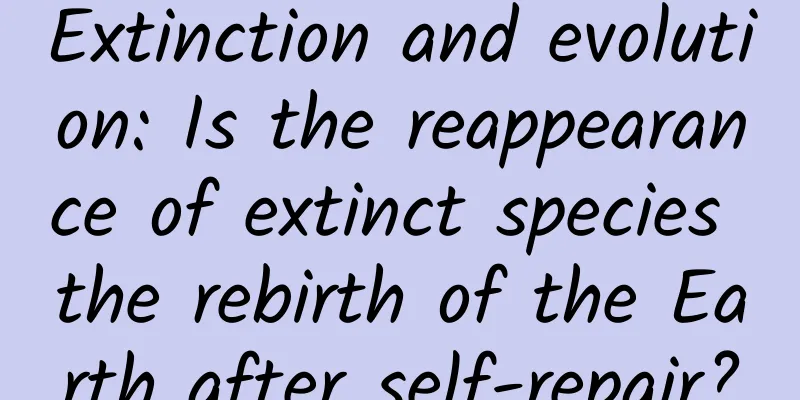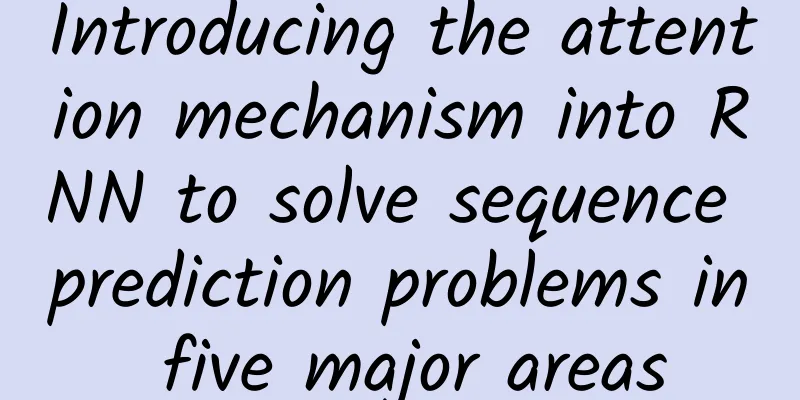Extinction and evolution: Is the reappearance of extinct species the rebirth of the Earth after self-repair?

|
Some netizens asked: some species that have been extinct for 50 years have reappeared in nature. Can the earth repair itself and bring species back to life? This article will talk about the cause of species extinction from this perspective, and whether the earth itself has the ability to repair itself. Let’s first talk about the laws of biological evolution and mass extinction on Earth. Since the emergence of life on Earth, species have been born and died. Modern scientific research believes that life appeared 3.7 billion years ago, but it was not until the beginning of the Cambrian period 570 million years ago that it appeared in a visible form. Therefore, people call the history of biological evolution after the Cambrian period the Phanerozoic, which means that life appeared. The Phanerozoic Eon has experienced five mass extinction events so far, which were basically caused by changes in the earth's environment and climate disasters. In each mass extinction event, about 80% to 95% of species became extinct, and countless new species evolved afterwards. This is how the earth's ecology is, surviving to this day in the alternation of extinction and prosperity. The last mass extinction was the Cretaceous extinction 65 million years ago. The most notable sign was the extinction of the dinosaur family that had ruled the Earth for 160 million years, along with about 80% of species. However, research suggests that dinosaurs were not truly extinct, as some dinosaur species evolved into today's birds. Therefore, dinosaurs are also the ancestors of today's birds. This mass extinction created conditions for the rise of mammals. Humans are the most intelligent creatures among mammals. Therefore, the emergence of humans benefited from the extinction of dinosaurs, and many new species also benefited from this mass extinction. Therefore, extinction itself does not seem to be a bad thing for the evolution of species, but a kind of progress. Through the study of the history of biological evolution, people have found that after each mass extinction event, there is a restart of biological prosperity, an interruption and upgrade of biological evolution, which is called quantitative change to qualitative change in philosophy. Every time the life restarted after extinction is much more advanced than before. Life on Earth has developed from nothing to multi-celled organisms, from anaerobic to aerobic, from invertebrates to vertebrates, from aquatic to terrestrial, from reptiles to mammals, and finally from the lowest level to the highest level. Humans are the biggest winners in the 4.5 billion years since the Earth was born, becoming the master of all things. Many scientists believe that we have entered the sixth mass extinction of organisms. In addition to changes in the earth's environment itself, the environmental changes caused by human activities cannot be ignored, especially the greenhouse effect caused by carbon emissions, which has reached the point of endangering human survival. Scientists have repeatedly called for us to have little time left. If we do not curb and change, it is very likely that humans will suffer a catastrophe by the end of this century. This is by no means alarmist, but the content of two open letters jointly issued by scientists around the world in 1992 and 2017, which are repeated calls and warnings to all mankind. The Paris Agreement initiated by the United Nations and signed by countries around the world is to solve this problem. I have said this many times in the past, so I will not go into details here. Let’s talk about which species became extinct 50 years ago and are now reappearing. Since the emergence of humans, especially since industrialization, the environment has been plundered and exploited wantonly, causing damage to the ecosystem. We are experiencing the sixth mass extinction of life on Earth, which is closely related to human activities. Evidence shows that in the past 200 million years, an average of 90 species of vertebrates have gone extinct every 100 years, and one higher plant has gone extinct every 27 years. After human activities, this rate has increased by nearly 1,000 times. In the past 1,600 years, 724 higher animals and plants have been recorded to have gone extinct, and the number that is not recorded may be far greater than this. Some scientists estimate that as many as 2 million species actually became extinct in the 20th century, with as many as 140,000 species becoming extinct every year. According to a study by Jeremy Thomas, a scientist at the Centre for Ecology and Hydrology in the UK, native bird species in the UK have declined by 54% over the past 40 years, while wild animals and plants have declined by 28%. The number of butterfly species has also declined by an astonishing 71%, indicating that insects are also facing extinction. The study was published in the journal Science. Therefore, if we want to count the species that have become extinct, we really can't count them all, because new species have become extinct yesterday and today. So what species became extinct 50 years ago? I can't find any information on this, so I will just briefly talk about some animals that have been declared extinct and have reappeared to illustrate this issue. The most common bird on the Internet is the Giant Moorhen, which is about 60 cm long and weighs about 2 kg. It was once found all over the South and North Islands of New Zealand. Since the Maori arrived here 1,000 years ago, the Giant Moorhen, which has delicious meat, has become their target of hunting. The pigs, dogs, cats, rabbits, cows, foxes, mice and other mammals brought to the island by these people destroyed the food chain while preying on the Giant Moorhen, causing the number of Giant Moorhen to drop sharply. By the 1930s, people believed that this giant bird had become extinct. 50 years ago, the local government officially announced the extinction of the giant moorhen. Unexpectedly, people have discovered traces of this giant bird today, so they have strengthened its protection. Now the number has grown to 300, but it is still less than the 1,864 giant pandas, which shows how precious it is. There is a wild dog living in the forests of the mountains of New Guinea, called the "singing dog", named for its unique barking, which is sometimes high-pitched and sometimes low, and sounds a bit like a gentle song. This dog was declared extinct 50 years ago, but the Mirror reported on September 1, 2020 that researchers rediscovered this wild dog during an expedition on the island of New Guinea. The elephant shrew looks more like a mouse, but is more closely related to elephants, hence its name. From the fossil evidence that has been discovered, its morphology has hardly changed in 23 million years, which earns it the title of a living fossil species. This animal has not appeared for 54 years and was thought to be extinct in the wild, but was discovered in the wild again in August 2020. In fact, not only species that disappeared 50 years ago will reappear, but also species that were thought to be extinct for thousands or tens of thousands of years have been rediscovered. For example, the Gransirius ant, which was thought to be extinct 20 million years ago, was discovered in Paraguay in 2006; the steppe boar, which was thought to be extinct 10,000 years ago, was discovered in 1981; the New Guinea big-eared bat, which was considered extinct by humans in 1890, was rediscovered in 2012, and so on. Decades of practice have proven that human intervention and protection can save some animals. For example, my country's giant panda, under human protection, has now grown to 1,864 individuals, and has been removed from the endangered species list and upgraded to vulnerable species. In recent years, many species, including the southern long-nosed bat, Przewalski's horse, humpback whale, bald eagle, Arabian oryx, West Indian manatee, mountain gorilla, etc., have been pulled back from the edge of endangered or critically endangered. So, is the reappearance of extinct species the result of the Earth’s self-healing? I think we cannot simply assume that there are many possible situations when declaring a species extinct, including but not limited to: 1. It is really extinct; 2. It is just very rare and has not been seen by humans. If a species is truly extinct, it will no longer appear. However, in the wild and uninhabited forests, where few people go, some endangered species with very few stocks are difficult to find. Generally speaking, if a species has not been found for 50 years, it will be considered extinct. However, being considered extinct does not mean that it is really extinct. There are also species that have slipped through the net and have not been found and are mistakenly considered extinct. Therefore, the reappearance of "extinct" species is not due to the restoration of the earth's ecology, but simply because these species have been discovered again. Of course, there may also be factors that the earth's ecology has improved and these species have reproduced more. Nowadays, declaring a species extinct is becoming more and more standardized, and the more authoritative organization is the International Union for Conservation of Nature, or IUCN for short. IUCN has been compiling the Red List of Threatened Species (IUCN Red List) since 1963. In this list, 5,734 endangered species were listed in 2012, including 3,079 animals and 1,197 plants. Among endangered species, there are four levels: endangered, critically endangered, extinct in the wild, and extinct; and above endangered, there are several levels: least concern, near threatened, and vulnerable. my country's giant pandas are already vulnerable. Generally speaking, extinction mainly refers to extinction in the wild. Some species have been bred and reproduced in captivity, which does not mean that the species in the wild have not become extinct; while complete extinction means that there are no more species in captivity. According to statistics, 75 species become extinct every day in the world, and 3 species become extinct every hour. Species extinction is a chain reaction. The extinction of some species will lead to the break of the species chain, causing a series of species extinctions. For example, the southern long-nosed bat was once an endangered species and is the main pollinator of agave. If the southern long-nosed bat becomes extinct, agave will also have difficulty surviving alone. Therefore, the acceleration of species extinction will cause a series of chain reactions, eventually leading to the breakup of the entire species chain and a mass extinction of ecological collapse. Scientists believe that the Earth is facing the sixth mass extinction. Dr. Jiang Zhigang, chief researcher at the Institute of Zoology, Chinese Academy of Sciences and executive deputy director of the China Endangered Species Science Committee, believes that the Earth has entered the sixth mass extinction period since the Industrial Revolution. So does the Earth's ecology have the ability to heal and repair itself? Of course, this is certain, provided that humans stop destroying it, and nature will recover according to its natural laws. But one thing that needs to be explained is that the natural environment itself will continue to change according to geological changes and solar radiation. These changes are not friendly to every species. Some species that cannot adapt will gradually decrease and eventually become extinct, while new species that adapt to the environment will emerge. At present, the damage to the environment by humans is mainly caused by greenhouse gas emissions caused by the burning of fossil fuels, which has caused the average temperature of the earth to rise. Some studies have shown that the average temperature of the earth has risen by 1 degree Celsius since industrialization, and the average temperature rise of 3 degrees Celsius is a threshold. Once this critical point is reached, the self-regulating system of the earth's climate will collapse, extreme climate and environmental disasters will come, and it will be difficult for humans to escape. The Paris Agreement is a commitment signed by all countries to reduce energy consumption and emissions in an effort to limit the temperature rise to within 2 degrees Celsius by the end of this century. But can this goal be achieved? Judging from the current chaotic situation in the world, the prospects are worrying. Many scientists pessimistically believe that if things go wrong, it will be difficult for humans to survive the extinction crisis at the end of this century. After a mass extinction, after hundreds of millions of years of incubation and evolution, new species that adapt to the new environment will flourish again. But if humans really die out, there will be no humans in the new world. Therefore, for the sake of future generations, we must cherish the present, respond to the call of scientists, start with ourselves, and reduce carbon emissions. Everyone's power is very limited, but if everyone in the world can do this, we will gather a powerful force and achieve carbon neutrality in the shortest possible time, saving the earth's ecology and saving ourselves. What do you think about this? Welcome to discuss, thank you for reading. The copyright of Space-Time Communication is original. Please do not infringe or plagiarize. Thank you for your understanding and cooperation. |
>>: Will eating noodles lead to malnutrition? 8 points to know
Recommend
Why do some people see the "devil's face"? It may be related to "visual impairment"...
Leviathan Press: I have heard before that the rea...
up to date! Baidu 360, Sogou or Shenma search, which channel has more traffic?
Many people believe that China has a large popula...
How to operate Douyin for your business from 0 to 1?
When companies first start using TikTok, they oft...
Tesla factory is coming! The Chinese factory site is expected to be announced this year
The development momentum of new energy vehicles i...
During the Chinese New Year, the power of this thing is second only to the sugar orange →
Meatballs, also called dumplings, represent perfe...
Shen Bai Bu Bai · External docking voice hang-up project, no real person appearance is required, the basic income for one person is 200+
Shen Bai Bu Bai · External docking voice hang-up ...
Can a cup of coffee a day cause anemia? Nutritionists reveal the truth!
In recent years, more and more people have begun ...
Use Retrofit+RxJava+MVP to create a Material Design style APP
In order to get familiar with the use of some ope...
Don’t know how to promote events? Here is a set of event operation templates!
Written in front: The protagonist of this templat...
The cost of leads is so low! Beauty training information flow delivery case
The National Day is coming soon. This article wil...
Sony makes money quietly by selling components to increase company profits
June 10: Tens of millions of consumers around the...
Samsung hits back at stress test: Who told you to use such high pressure?
Last Friday, SquareTrade, a third-party smartphon...
Introduction to 360 Search Golden Booth CPT Advertising Promotion!
360 Search Gold Booth Introduction to the advanta...









